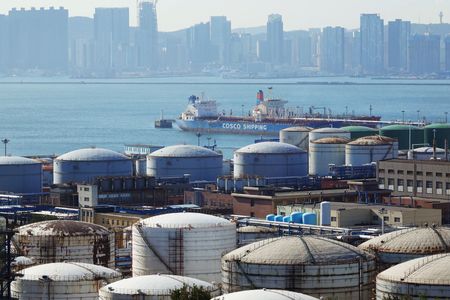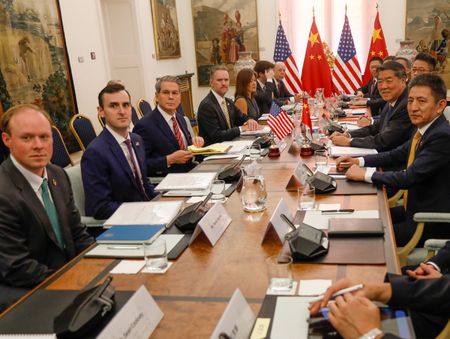By David Lawder
WASHINGTON (Reuters) – The U.S. Trade Representative’s office has proposed charging up to $1.5 million for Chinese-built vessels entering U.S. ports as part of its investigation into China’s growing domination of the global shipbuilding, maritime and logistics sectors.
USTR said in a January 16 report on a probe launched during the administration of former President Joe Biden that China increased its share of global shipbuilding tonnage from 5% in 1999 to over 50% in 2023 because of massive state subsidies and preferential treatment for state-owned enterprises that are squeezing out private-sector international competitors. The agency said that U.S. shipyards were building 70 ships in 1975, but just five annually today.
In a Federal Register notice published late on Friday, USTR detailed its proposed fees and other shipping restrictions. The agency scheduled a March 24 public hearing on the remedies.
The probe was launched in April 2024 at the request of the United Steelworkers and four other unions, and conducted under Section 301 of the Trade Act of 1974, as a way to rebuild an industry that has been in deep decline since the 1970s, when Japan and South Korea dominated shipbuilding. The results of the probe were announced last month, just days before Donald Trump was sworn in as president.
The proposed remedies include port entrance fees of up to $1 million per vessel owned by Chinese maritime transport operators, such as the state-owned China Ocean Shipping Co Ltd. Alternatively, the U.S. would charge $1,000 per net ton of a vessel’s cargo capacity.
Non-Chinese maritime transport operators operating Chinese-built ships would pay up to $1.5 million per port entry, according to the notice. Those with greater than 50% Chinese-built fleets would pay $1 million per vessel entry regardless of origin. The fee would fall to $750,000 if the Chinese fleet percentage was between 25% and 50% and to $500,000 if under 25%.
A second set of fees in similar amounts could apply to maritime operators with vessels on order from Chinese shipyards to be delivered over the next two years.
USTR said that under the proposal the fees could be refunded by up to $1 million per entry into a U.S. port by a U.S.-built vessel employed in international maritime services.
U.S. VESSEL REQUIREMENTS
The remedies also would require at least 1% of U.S. exports to be shipped on U.S. flagged-vessels for the first two years, including capital goods, consumer goods, agricultural products, and chemical petroleum and gas products.
The percentage would increase to 3% U.S. exports after two years, and 5% after three years. After three years, 3% of U.S. exports would have to be shipped on American-built ships.
After seven years, the restrictions would require at least 15% of U.S. goods to be transported on U.S.-flagged vessels, with 5% on American-built ships.
USTR also said that it recommends restricting access to U.S. shipping data for China’s National Transportation and Logistics Public Information Platform or banning U.S. port terminals from using LOGINK software.
(Reporting by David Lawder; Editing by Leslie Adler)











